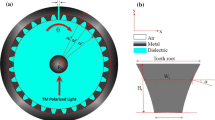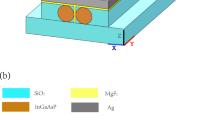Abstract
The hybrid surface plasmon polariton waveguide (HSPPWG) can carry and manipulate optical signals in nanoscale conduits. As a type of plasmonic waveguide, the HSPPWG helps designers to increase speed and develop high-density interlayer connections in order to improve network bandwidth and data transmission rates for future optical communication networks. The HSPPWG is a versatile photonics and integrated optics platform because of its unique characteristics. To achieve high efficiency, the quantum dot (QD) was used in the proposed structure and simulated it with the COMSOL Multiphysics software together with MATLAB. The main objective of the study is to increase the propagation length compared to conventional structure (without QD) while maintaining good quantitative confinement according to the figure of merit (FoM) test and confinement factor. We show that the confinement factor (Γ) at n2D of 17.8 × 1010 cm−2 and QDisk of 3 nm height provides superior confinement compared to QDisk heights 2 nm and 4 nm. The figure of merit at 1550 nm is approximately 105, outperforming the FoM value in the traditional case without quantum dots. The FoM at most wavelengths exceeds that of the traditional state. The propagation length (Lp) values at a QDisk height of 3 nm are 38 µm and 32 μm at 1550 nm and 1300 nm, respectively. The Lp of the SPP in the HSPPWG did not show a significant increase at wavelengths 1300 nm and 1550 nm. Therefore, we replaced the used InP semiconductors with other semiconductor materials such as AlGaAs. The Lp at the wavelength of 1550 nm reached 67.7 μm at a refractive index of 3.0238.















Similar content being viewed by others
Data Availability
The data cannot be shared publicly but is available upon request to other authors or editors.
References
A.S. Baburin, A.M. Merzlikin, A.V. Baryshev, I.A. Ryzhikov, Y.V. Panfilov, I.A. Rodionov, Silver-based plasmonics: golden material platform and application challenges [Invited]. Opt. Mater. Express 9(2), 611 (2019). https://doi.org/10.1364/OME.9.000611
J. Henzie, J. Lee, M.H. Lee, W. Hasan, T.W. Odom, Nanofabrication of plasmonic structures. Annu. Rev. Phys. Chem. 60(1), 147–165 (2009). https://doi.org/10.1146/annurev.physchem.040808.090352
M.B.E.N. Rhouma, “Modeling and simulation of composite plasmonic structures based on graphene and metals”, (2021).
S.K. Gray, Theory and modeling of plasmonic structures. J. Phys. Chem. C 117(5), 1983–1994 (2013). https://doi.org/10.1021/jp309664c
Y. Li, “Surface plasmon polaritons at planar interfaces”, in Plasmonic Optics Theory and Applications. SPIE PRESS, pp. 41–66 (2017). https://doi.org/10.1117/3.2263757.ch2
K. Shah, “5 Surface plasmon polaritons (SPP)”, in Plasma and Plasmonics, De Gruyter, pp. 55–70 (2018). https://doi.org/10.1515/9783110570038-065
G. Barbillon, “Plasmonics and its applications”, Materials (Basel) vol. 12 (no. 9), (2019). https://doi.org/10.3390/ma12091502
Y. Li, “Optical properties of plasmonic materials”, in Plasmonic Optics Theory and Applications. SPIE PRESS (2017). https://doi.org/10.1117/3.2263757.ch1
I. Suárez et al., Propagation length enhancement of surface plasmon polaritons in gold nano-/micro-waveguides by the interference with photonic modes in the surrounding active dielectrics. Nanophotonics 6(5), 1109–1120 (2017). https://doi.org/10.1515/nanoph-2016-0166
D.K. Gramotnev, S.I. Bozhevolnyi, Plasmonics beyond the diffraction limit. Nat. Photonics 4(2), 83–91 (2010). https://doi.org/10.1038/nphoton.2009.282
P. Berini, Long-range surface plasmon polaritons vol. 1 (no. 3), (2009). https://doi.org/10.1364/aop.1.000484
S. A. Maier, “Surface plasmon polaritons at metal / insulator interfaces,” Plasmon. Fundam. Appl., vol. 0, pp. 21–37, 2007, doi: https://doi.org/10.1007/0-387-37825-1_2.
P. Dawson, B.A.F. Puygranier, J.P. Goudonnet, “Surface plasmon polariton propagation length: a direct comparison using photon scanning tunneling microscopy and attenuated total reflection”, Phys Rev B - Condens Matter Mater Phys vol. 63(no. 20) (2001). https://doi.org/10.1103/PhysRevB.63.205410
J. Zhang, L. Zhang, W. Xu, Surface plasmon polaritons: physics and applications. J. Phys. D Appl. Phys. 45(11), 113001 (2012). https://doi.org/10.1088/0022-3727/45/11/113001
M. Mohammadi, M. Soroosh, A. Farmani, S. Ajabi, “Engineered FWHM enhancement in plasmonic nanoresonators for multiplexer/demultiplexer in visible and NIR range”, Optik (Stuttg) vol. 274, p. 170583 (2023). https://doi.org/10.1016/j.ijleo.2023.170583
F. Bagheri, M. Soroosh, Design and simulation of compact graphene-based plasmonic flip-flop using a resonant ring. Diam. Relat. Mater. 136, 109904 (2023). https://doi.org/10.1016/j.diamond.2023.109904
M. Mohammadi, M. Soroosh, A. Farmani, S. Ajabi, High-performance plasmonic graphene-based multiplexer/demultiplexer. Diam. Relat. Mater. 139, 110365 (2023)
Z. Salehnezhad, M. Soroosh, A. Farmani, Design and numerical simulation of a sensitive plasmonic-based nanosensor utilizing MoS2 monolayer and graphene. Diam. Relat. Mater. 131, 109594 (2023). https://doi.org/10.1016/j.diamond.2022.109594
S. Sun, H.-T. Chen, W.-J. Zheng, G.-Y. Guo, Dispersion relation, propagation length and mode conversion of surface plasmon polaritons in silver double-nanowire systems. Opt. Express 21(12), 14591 (2013). https://doi.org/10.1364/oe.21.014591
M.J. Maleki, M. Soroosh, A low-loss subwavelength plasmonic waveguide for surface plasmon polariton transmission in optical circuits. Opt. Quantum Electron. 55(14), 1266 (2023)
M.J. Maleki, M. Soroosh, G. Akbarizadeh, A subwavelength graphene surface plasmon polariton-based decoder. Diam. Relat. Mater. 134, 109780 (2023)
F. Bagheri, M. Soroosh, F. Haddadan, Y. Seifi-Kavian, Design and simulation of a compact graphene-based plasmonic D flip-flop. Opt. Laser Technol. 155, 108436 (2022). https://doi.org/10.1016/j.optlastec.2022.108436
F. Haddadan, M. Soroosh, N. Alaei-Sheini, Cross-talk reduction in a graphene-based ultra-compact plasmonic encoder using an Au nano-ridge on a silicon substrate. Appl. Opt. 61(11), 3209–3217 (2022)
C.Y. Chunwei Ye, Y.L. Yumin Liu, J.W. Jie Wang, H.L. Hongbo Lv, and Z.Y. Zhongyuan Yu, “Graded-index ridge surface plasmon polaritons waveguide”, Chinese Opt Lett, vol. 12(no. 9), pp. 092402–092405 (2014). https://doi.org/10.3788/col201412.092402
I. Minin and O. Minin, Diffractive optics and nanophotonics: resolution below the diffraction limit, vol. 4,(2015)
J.R. Krenn et al., Non-diffraction-limited light transport by gold nanowires. Europhys. Lett. 60(5), 663–669 (2002). https://doi.org/10.1209/epl/i2002-00360-9
J.N. Jabir, S.M.M. Ameen, A. Habbeb Al-Khursan, “Giant net modal gain of plasmonic quantum dot nanolaser”, J Phys Conf Ser vol. 1294 (no. 2), p. 022031 (2019). https://doi.org/10.1088/1742-6596/1294/2/022031
M. Castro-Lopez, A. Manjavacas, J. García de Abajo, N.F. van Hulst, Propagation and localization of quantum dot emission along a gap-plasmonic transmission line. Opt. Express 23(23), 29296 (2015). https://doi.org/10.1364/oe.23.029296
L. Seravalli, F. Sacconi, “Reviewing quantum dots for single-photon emission at 1.55 µm: a quantitative comparison of materials”, J Phys Mater vol. 3,(no. 4), (2020). https://doi.org/10.1088/2515-7639/abbd36
J. Wang, Y.X. Guo, B.H. Huang, S.P. Gao, Y.S. Xia, A silicon-based hybrid plasmonic waveguide for nano-scale optical confinement and long range propagation. IEEE Trans. Nanotechnol. 18, 437–444 (2019). https://doi.org/10.1109/TNANO.2019.2911333
X. Zhou, T. Zhang, L. Chen, W. Hong, X. Li, A graphene-based hybrid plasmonic waveguide with ultra-deep subwavelength confinement. J. Light. Technol. 32(21), 4199–4203 (2014). https://doi.org/10.1109/JLT.2014.2350487
T. Ma et al., Graphene-coated two-layer dielectric loaded surface plasmon polariton rib waveguide with ultra-long propagation length and ultra-high electro-optic wavelength tuning. IEEE Access 8, 103433–103442 (2020). https://doi.org/10.1109/ACCESS.2020.2999395
N.T. Huong, N.D. Vy, M.T. Trinh, C.M. Hoang, “Tuning SPP propagation length of hybrid plasmonic waveguide by manipulating evanescent field”, Opt Commun vol. 462, p. 125335 (2020). https://doi.org/10.1016/j.optcom.2020.125335
Z. Zhang, J. Wang, Long-range hybrid wedge plasmonic waveguide. Sci. Rep. 4(1), 6870 (2014). https://doi.org/10.1038/srep06870
P. Suvarnaphaet, S. Pechprasarn, “Enhancement of long-range surface plasmon excitation, dynamic range and figure of merit using a dielectric resonant cavity”, Sensors (Switzerland) vol. 18 (no. 9), (2018) https://doi.org/10.3390/s18092757
Y. Li, “Surface plasmon polariton waveguides”, Plasmonic OptTheory Appl, pp. 135–160 (2017). https://doi.org/10.1117/3.2263757.ch5
J. Xiao et al., A CMOS-compatible hybrid plasmonic slot waveguide with enhanced field confinement. IEEE Electron Device Lett. 37(4), 456–458 (2016). https://doi.org/10.1109/LED.2016.2531990
S. Sederberg, C.J. Firby, S.R. Greig, A.Y. Elezzabi, Integrated nanoplasmonic waveguides for magnetic, nonlinear, and strong-field devices. Nanophotonics 6(1), 235–257 (2017). https://doi.org/10.1515/nanoph-2016-0135
R. Buckley, P. Berini, Figures of merit for 2D surface plasmon waveguides and application to metal stripes. Opt. Express 15(19), 12174 (2007). https://doi.org/10.1364/oe.15.012174
S. Aldawsari, “Comprehensive theoretical studies of guided modes in multilayer hybrid plasmonic waveguides by”, University of Waterloo (2018). [Online]. Available: http://hdl.handle.net/10012/13223
W.F. Shneen, S. Mahdi, M. Ameen, “Long-range hybrid plasmonic waveguide of graded-index InGaAsP active layer based on InP”, https://doi.org/10.21203/rs.3.rs-1735858/v1
S. Aldawsari, Aldawsari Sarah “Nonlinear hybrid plasmonic waveguides", University of Waterloo, (2013). [Online]. Available: http://hdl.handle.net/10012/7633
L. Vinet, A. Zhedanov, A “missing” family of classical orthogonal polynomials, vol. 44(no. 8), John Wiley & Sons, Inc., (2011). https://doi.org/10.1088/1751-8113/44/8/085201
J.N. Jabir, S.M.M. Ameen, A.H. Al-Khursan, Modeling of dielectric function in plasmonic quantum dot nanolaser. Opt. Quantum Electron. 51(12), 1–13 (2019). https://doi.org/10.1007/s11082-019-2117-0
S. Kumar, S.I. Bozhevolnyi, Excitation of hybrid plasmonic waveguide modes by colloidal quantum dots. ACS Photonics 6(7), 1587–1593 (2019). https://doi.org/10.1021/acsphotonics.9b00379
A.V. Krasavin, A.V. Zayats, Active nanophotonic circuitry based on dielectric-loaded plasmonic waveguides. Adv. Opt. Mater. 3(12), 1662–1690 (2015). https://doi.org/10.1002/adom.201500329
X. Guo, Y. Ying, L. Tong, Photonic nanowires: from subwavelength waveguides to optical sensors. Acc. Chem. Res. 47(2), 656–666 (2014). https://doi.org/10.1021/ar400232h
V.E. Babicheva, I.V. Kulkova, R. Malureanu, K. Yvind, A.V. Lavrinenko, Plasmonic modulator based on gain-assisted metal-semiconductor-metal waveguide. Photonics Nanostructures - Fundam. Appl. 10(4), 389–399 (2012). https://doi.org/10.1016/j.photonics.2012.05.008
P. Berini, I. De Leon, Surface plasmon-polariton amplifiers and lasers. Nat. Photonics 6(1), 16–24 (2012). https://doi.org/10.1038/nphoton.2011.285
N. Dordevic, “Colloidal quantum dot absorption and luminescence for optoelectronics : from machine learning to plasmonic-enhanced devices”, (2021). https://doi.org/10.3929/ethz-b-000503335
T. Zhang, F. Shan, “Development and application of surface plasmon polaritons on optical amplification”, J Nanomater vol. 2014 (2014). https://doi.org/10.1155/2014/495381.
K. Ahmed, Surface plasmon lasers: quantum dot. J. Comput. Sci. Technol. Stud. 4(2), 165–171 (2022). https://doi.org/10.32996/jcsts.2022.4.2.20
G.M. Almzargah, M.M. Tohari, “Tunable switching between slow and fast light in the graphene nanodisks (GND)–quantum dot (QD) plasmonic hybrid systems", Nanomaterials vol. 13(no. 5) (2023). https://doi.org/10.3390/nano13050834
J. Kim, S.L. Chuang, Theoretical and experimental study of optical gain, refractive index change, and linewidth enhancement factor of p-doped quantum-dot lasers. IEEE J. Quantum Electron. 42(9), 942–952 (2006). https://doi.org/10.1109/JQE.2006.880380
Y.Z. Huang, Comparison of modal gain and material gain for strong guiding slab waveguides. IEE Proc. Optoelectron. 148(3), 131–133 (2001). https://doi.org/10.1049/ip-opt:20010519
Y.Z. Huang, Z. Pan, R.H. Wu, Analysis of the optical confinement factor in semiconductor lasers. J. Appl. Phys. 79(8), 3827–3830 (1996). https://doi.org/10.1063/1.361809
H. Ju, “Kramers–Kronig relation for attenuated total reflection from a metal–dielectric interface where surface plasmon polaritons are excited”, Nanomaterials vol. 11(no. 11) (2021). https://doi.org/10.3390/nano11113063
M. Mirahmadi, T. Mahinroosta, S.M. Hamidi, Manipulating plasmon-exciton interactions in the plasmonic waveguide structure based on the dispersion relations concept. Opt. Quantum Electron. 52(6), 1–9 (2020). https://doi.org/10.1007/s11082-020-02429-y
N. Asgari, S.M. Hamidi, Exciton-plasmon coupling in two-dimensional plexitonic nano grating. Opt. Mater. (Amst) 81(May), 45–54 (2018). https://doi.org/10.1016/j.optmat.2018.05.011
W.A. Harrison, Elementary theory of heterojunctions. J. Vac. Sci. Technol. 14(4), 1016–1021 (1977). https://doi.org/10.1116/1.569312
I. Vurgaftman, J.R. Meyer, L.R. Ram-Mohan, “Band parameters for III-V compound semiconductors and their alloys”, J Appl Phys vol. 89(no. 11 I), pp. 5815–5875 (2001) https://doi.org/10.1063/1.1368156
S. Editors, P.A.K. Von Klitzing, H.S.R. Wiesen, Science and technology, vol. 24(no. 7). Berlin, Heidelberg: Springer Berlin Heidelberg, (1997). https://doi.org/10.1007/978-3-662-05001-9
S. Adachi, “GaAs, AlAs, and AlxGa1-xAs”, J Appl Phys vol. 58(no. 3) (1985). https://doi.org/10.1063/1.336070
E. Ochoa-Martínez et al., Refractive indexes and extinction coefficients of n- and p-type doped GaInP, AlInP and AlGaInP for multijunction solar cells. Sol. Energy Mater. Sol. Cells 174, 388–396 (2018). https://doi.org/10.1016/j.solmat.2017.09.028
D. Jung, L. Yu, S. Dev, D. Wasserman, M.L. Lee, Design and growth of multi-functional InAsP metamorphic buffers for mid-infrared quantum well lasers on InP. J. Appl. Phys. 125(8), 1–8 (2019). https://doi.org/10.1063/1.5054574
B. Broberg, S. Lindgren, Refractive index of In1-xGaxAsyP 1-y layers and InP in the transparent wavelength region. J. Appl. Phys. 55(9), 3376–3381 (1984). https://doi.org/10.1063/1.333377
M. Schubert, “Optical constants of Ga x In 1- x P lattice matched to GaAs”, pp. 4–9 (1995)
A. Bernard et al., Mid-infrared optical characterization of InGaAsP. J. Opt. Soc. Am. B 35(12), C25 (2018). https://doi.org/10.1364/josab.35.000c25
Author information
Authors and Affiliations
Contributions
The authors’ contribution is equal.
Corresponding author
Ethics declarations
Conflict of Interest
The authors declare no competing interests.
Additional information
Publisher's Note
Springer Nature remains neutral with regard to jurisdictional claims in published maps and institutional affiliations.
Rights and permissions
Springer Nature or its licensor (e.g. a society or other partner) holds exclusive rights to this article under a publishing agreement with the author(s) or other rightsholder(s); author self-archiving of the accepted manuscript version of this article is solely governed by the terms of such publishing agreement and applicable law.
About this article
Cite this article
Shneen, W.F., Ameen, S.M.M. Controllable Surface Plasmon Polariton Propagation Length Using a Suitable Quantum Dot Material. Braz J Phys 54, 59 (2024). https://doi.org/10.1007/s13538-024-01425-x
Received:
Accepted:
Published:
DOI: https://doi.org/10.1007/s13538-024-01425-x




